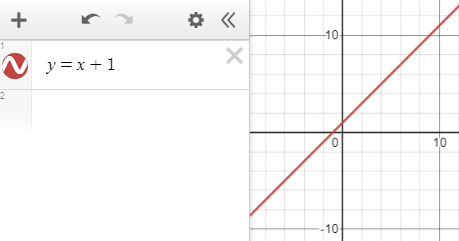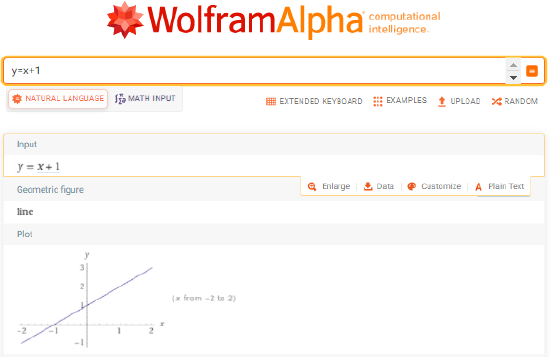1.4: Graphing
- Page ID
- 93862
\( \newcommand{\vecs}[1]{\overset { \scriptstyle \rightharpoonup} {\mathbf{#1}} } \)
\( \newcommand{\vecd}[1]{\overset{-\!-\!\rightharpoonup}{\vphantom{a}\smash {#1}}} \)
\( \newcommand{\dsum}{\displaystyle\sum\limits} \)
\( \newcommand{\dint}{\displaystyle\int\limits} \)
\( \newcommand{\dlim}{\displaystyle\lim\limits} \)
\( \newcommand{\id}{\mathrm{id}}\) \( \newcommand{\Span}{\mathrm{span}}\)
( \newcommand{\kernel}{\mathrm{null}\,}\) \( \newcommand{\range}{\mathrm{range}\,}\)
\( \newcommand{\RealPart}{\mathrm{Re}}\) \( \newcommand{\ImaginaryPart}{\mathrm{Im}}\)
\( \newcommand{\Argument}{\mathrm{Arg}}\) \( \newcommand{\norm}[1]{\| #1 \|}\)
\( \newcommand{\inner}[2]{\langle #1, #2 \rangle}\)
\( \newcommand{\Span}{\mathrm{span}}\)
\( \newcommand{\id}{\mathrm{id}}\)
\( \newcommand{\Span}{\mathrm{span}}\)
\( \newcommand{\kernel}{\mathrm{null}\,}\)
\( \newcommand{\range}{\mathrm{range}\,}\)
\( \newcommand{\RealPart}{\mathrm{Re}}\)
\( \newcommand{\ImaginaryPart}{\mathrm{Im}}\)
\( \newcommand{\Argument}{\mathrm{Arg}}\)
\( \newcommand{\norm}[1]{\| #1 \|}\)
\( \newcommand{\inner}[2]{\langle #1, #2 \rangle}\)
\( \newcommand{\Span}{\mathrm{span}}\) \( \newcommand{\AA}{\unicode[.8,0]{x212B}}\)
\( \newcommand{\vectorA}[1]{\vec{#1}} % arrow\)
\( \newcommand{\vectorAt}[1]{\vec{\text{#1}}} % arrow\)
\( \newcommand{\vectorB}[1]{\overset { \scriptstyle \rightharpoonup} {\mathbf{#1}} } \)
\( \newcommand{\vectorC}[1]{\textbf{#1}} \)
\( \newcommand{\vectorD}[1]{\overrightarrow{#1}} \)
\( \newcommand{\vectorDt}[1]{\overrightarrow{\text{#1}}} \)
\( \newcommand{\vectE}[1]{\overset{-\!-\!\rightharpoonup}{\vphantom{a}\smash{\mathbf {#1}}}} \)
\( \newcommand{\vecs}[1]{\overset { \scriptstyle \rightharpoonup} {\mathbf{#1}} } \)
\( \newcommand{\vecd}[1]{\overset{-\!-\!\rightharpoonup}{\vphantom{a}\smash {#1}}} \)
\(\newcommand{\avec}{\mathbf a}\) \(\newcommand{\bvec}{\mathbf b}\) \(\newcommand{\cvec}{\mathbf c}\) \(\newcommand{\dvec}{\mathbf d}\) \(\newcommand{\dtil}{\widetilde{\mathbf d}}\) \(\newcommand{\evec}{\mathbf e}\) \(\newcommand{\fvec}{\mathbf f}\) \(\newcommand{\nvec}{\mathbf n}\) \(\newcommand{\pvec}{\mathbf p}\) \(\newcommand{\qvec}{\mathbf q}\) \(\newcommand{\svec}{\mathbf s}\) \(\newcommand{\tvec}{\mathbf t}\) \(\newcommand{\uvec}{\mathbf u}\) \(\newcommand{\vvec}{\mathbf v}\) \(\newcommand{\wvec}{\mathbf w}\) \(\newcommand{\xvec}{\mathbf x}\) \(\newcommand{\yvec}{\mathbf y}\) \(\newcommand{\zvec}{\mathbf z}\) \(\newcommand{\rvec}{\mathbf r}\) \(\newcommand{\mvec}{\mathbf m}\) \(\newcommand{\zerovec}{\mathbf 0}\) \(\newcommand{\onevec}{\mathbf 1}\) \(\newcommand{\real}{\mathbb R}\) \(\newcommand{\twovec}[2]{\left[\begin{array}{r}#1 \\ #2 \end{array}\right]}\) \(\newcommand{\ctwovec}[2]{\left[\begin{array}{c}#1 \\ #2 \end{array}\right]}\) \(\newcommand{\threevec}[3]{\left[\begin{array}{r}#1 \\ #2 \\ #3 \end{array}\right]}\) \(\newcommand{\cthreevec}[3]{\left[\begin{array}{c}#1 \\ #2 \\ #3 \end{array}\right]}\) \(\newcommand{\fourvec}[4]{\left[\begin{array}{r}#1 \\ #2 \\ #3 \\ #4 \end{array}\right]}\) \(\newcommand{\cfourvec}[4]{\left[\begin{array}{c}#1 \\ #2 \\ #3 \\ #4 \end{array}\right]}\) \(\newcommand{\fivevec}[5]{\left[\begin{array}{r}#1 \\ #2 \\ #3 \\ #4 \\ #5 \\ \end{array}\right]}\) \(\newcommand{\cfivevec}[5]{\left[\begin{array}{c}#1 \\ #2 \\ #3 \\ #4 \\ #5 \\ \end{array}\right]}\) \(\newcommand{\mattwo}[4]{\left[\begin{array}{rr}#1 \amp #2 \\ #3 \amp #4 \\ \end{array}\right]}\) \(\newcommand{\laspan}[1]{\text{Span}\{#1\}}\) \(\newcommand{\bcal}{\cal B}\) \(\newcommand{\ccal}{\cal C}\) \(\newcommand{\scal}{\cal S}\) \(\newcommand{\wcal}{\cal W}\) \(\newcommand{\ecal}{\cal E}\) \(\newcommand{\coords}[2]{\left\{#1\right\}_{#2}}\) \(\newcommand{\gray}[1]{\color{gray}{#1}}\) \(\newcommand{\lgray}[1]{\color{lightgray}{#1}}\) \(\newcommand{\rank}{\operatorname{rank}}\) \(\newcommand{\row}{\text{Row}}\) \(\newcommand{\col}{\text{Col}}\) \(\renewcommand{\row}{\text{Row}}\) \(\newcommand{\nul}{\text{Nul}}\) \(\newcommand{\var}{\text{Var}}\) \(\newcommand{\corr}{\text{corr}}\) \(\newcommand{\len}[1]{\left|#1\right|}\) \(\newcommand{\bbar}{\overline{\bvec}}\) \(\newcommand{\bhat}{\widehat{\bvec}}\) \(\newcommand{\bperp}{\bvec^\perp}\) \(\newcommand{\xhat}{\widehat{\xvec}}\) \(\newcommand{\vhat}{\widehat{\vvec}}\) \(\newcommand{\uhat}{\widehat{\uvec}}\) \(\newcommand{\what}{\widehat{\wvec}}\) \(\newcommand{\Sighat}{\widehat{\Sigma}}\) \(\newcommand{\lt}{<}\) \(\newcommand{\gt}{>}\) \(\newcommand{\amp}{&}\) \(\definecolor{fillinmathshade}{gray}{0.9}\)- Setup and use Cartesian coordinate system.
- Graph equations in two variables.
René Descartes (1596-1650) was a French philosopher and mathematician. As a philosopher, he is famous for the saying “Cogito ergo sum” (“I think, therefore I am”), and his writings led many to consider him the Father of Modern Philosophy. Even today, a number of his writings are standard faire in university philosophy departments.
However, it is Descartes’ work in mathematics that forms the basis for this chapter, particularly his invention of the Cartesian Coordinate System which bears his name. Descartes’ invention of the coordinate system created an entirely new branch of mathematics called analytic geometry, which established a permanent link between the plane and solid geometry of the ancient Greeks and the algebra and analysis of modern mathematics. As a result of his work, mathematicians were able to describe curves with equations, unheard of before Descartes’ invention of the coordinate system. Rather than describing a circle as the “locus of all points equidistant from a given point,” mathematicians were now able to refer to a circle centered at the point (0, 0) with radius \(r\) as the graph of the equation \(x^2 + y^2 = r^2\).
The bridge created between geometry and analysis as a result of Descartes’ methods laid the groundwork for the discovery of the calculus by Newton and Leibniz. For his efforts, mathematicians often refer to Descartes as the Father of Analytic Geometry.
In this section, we will introduce readers to the Cartesian coordinate system and explain the correspondence between points in the plane and ordered pairs of numbers. Once an understanding of the coordinate system is sufficiently developed, we will develop the concept of the graph of an equation.
We begin with the definition of an ordered pair.
The construct \((x,y)\), where \(x\) and \(y\) are any real numbers, is called an ordered pair of real numbers.
\((4,3)\), \((−3,4)\), \((−2,−3)\), and \((3,−1)\) are examples of ordered pairs.
Pay particular attention to the phrase “ordered pairs.” Order matters. Consequently, the ordered pair \((x,y)\) is not the same as the ordered pair \((y,x)\), because the numbers are presented in a different order.
The Cartesian Coordinate System
Pictured in Figure \(\PageIndex{1}\) is a Cartesian Coordinate System. On a grid, we’ve created two real lines, one horizontal labeled \(x\) (we’ll refer to this one as the \(x\)-axis), and the other vertical labeled \(y\) (we’ll refer to this one as the \(y\)-axis).
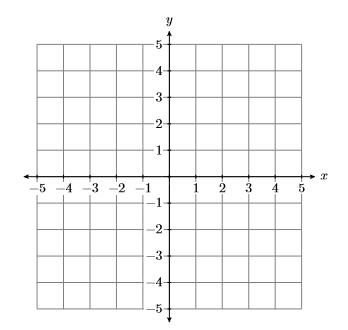
Two Important Points:
Here are two important points to be made about the horizontal and vertical axes in Figure \(\PageIndex{1}\).
- As you move from left to right along the horizontal axis (the \(x\)-axis in Figure \(\PageIndex{1}\)), the numbers grow larger. The positive direction is to the right, the negative direction is to the left.
- As you move from bottom to top along the vertical axis (the \(y\)-axis in Figure \(\PageIndex{1}\)), the numbers grow larger. The positive direction is upward, the negative direction is downward.
Additional Comments:

Two additional comments are in order:
- The point where the horizontal and vertical axes intersect in Figure \(\PageIndex{2}\) is called the origin of the coordinate system. The origin has coordinates \((0,0)\).
- The horizontal and vertical axes divide the plane into four quadrants, numbered \(\mathrm{I}, \mathrm{II}, \mathrm{MI},\) and \(\mathrm{IV}\) (roman numerals for one, two, three, and four), as shown in Figure \(\PageIndex{2}\). Note that the quadrants are numbered in a counter-clockwise order.
Rene Descartes (1596-1650) was a French philosopher and mathematician who is well known for the famous phrase“cogito ergo sum” (I think, therefore I am), which appears in his Discours de la methode pour bien conduire sa raison, et chercher la verite dans les sciences (Discourse on the Method of Rightly Conducting the Reason, and Seeking Truth in the Sciences). In that same treatise, Descartes introduces his coordinate system, a method for representing points in the plane via pairs of real numbers. Indeed, the Cartesian plane of modern day is so named in honor of Rene Descartes, who some call the “Father of Modern Mathematics”
Plotting Ordered Pairs
Before we can plot any points or draw any graphs, we first need to set up a Cartesian Coordinate System on a sheet of graph paper? How do we do this? What is required?
Draw and label each axis.
If we are going to plot points (x,y), then, on a sheet of graph paper, perform each of the following initial tasks.
- Use a ruler to draw the horizontal and vertical axes.
- Label the horizontal axis as the \(x\)-axis and the vertical axis as the \(y\)-axis.
We don’t always label the horizontal axis as the \(x\)-axis and the vertical axis as the \(y\)-axis. For example, if we want to plot the velocity of an object as a function of time, then we would be plotting points \((t,v)\). In that case, we would label the horizontal axis as the \(t\)-axis and the vertical axis as the \(v\)-axis.
Indicate the scale on each axis.
- Label at least one vertical gridline with its numerical value.
- Label at least one horizontal gridline with its numerical value.
The scales on the horizontal and vertical axes may differ. However, on each axis, the scale must remain consistent. That is, as you count to the right from the origin on the \(x\)-axis, if each gridline represents one unit, then as you count to the left from the origin on the \(x\)-axis, each gridline must also represent one unit. Similar comments are in order for the \(y\)-axis, where the scale must also be consistent, whether you are counting up or down.
The result of this first step is shown in Figure \(\PageIndex{3}\).
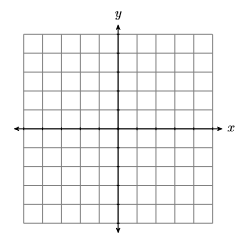
An example is shown in Figure \(\PageIndex{4}\). Note that the scale indicated on the \(x\)-axis indicates that each gridline counts as \(1\)-unit as we count from left-to-right. The scale on the \(y\)-axis indicates that each gridlines counts as \(2\)-units as we count from bottom-to-top.
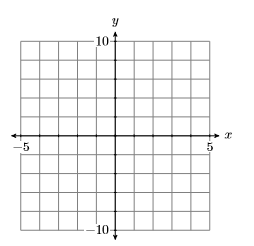
Now that we know how to set up a Cartesian Coordinate System on a sheet of graph paper, here are two examples of how we plot points on our coordinate system.
To plot the ordered pair \((4,3)\), start at the origin and move \(4\) units to the right along the horizontal axis, then \(3\) units upward in the direction of the vertical axis.
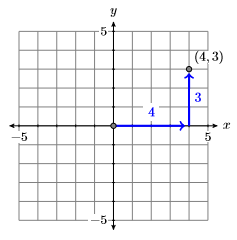
To plot the ordered pair \((−2,−3)\), start at the origin and move \(2\) units to the left along the horizontal axis, then \(3\) units downward in the direction of the vertical axis.
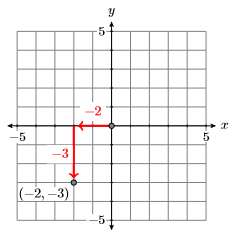
Interactive Exercise
Continuing in this manner, each ordered pair \((x,y)\) of real numbers is associated with a unique point in the Cartesian plane. Vice-versa, each point in the Cartesian point is associated with a unique ordered pair of real numbers. Because of this association, we begin to use the words “point” and “ordered pair” as equivalent expressions, sometimes referring to the “point” \((x,y)\) and other times to the “ordered pair” \((x,y)\).
Identify the coordinates of the point \(P\) in Figure \(\PageIndex{7}\).
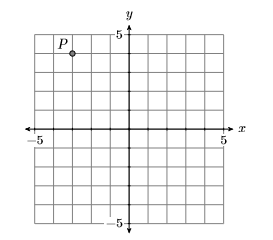
Solution
In Figure \(\PageIndex{8}\), start at the origin, move \(3\) units to the left and \(4\) units up to reach the point \(P\). This indicates that the coordinates of the point \(P\) are \((−3,4)\).
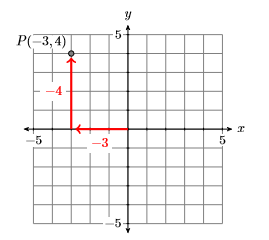
Identify the coordinates of the point \(P\) in the graph below.
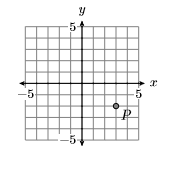
- Answer
-
\((3,-2)\)
Interactive Exercise \(\PageIndex{1}\)
Equations in Two Variables
The variables do not have to always be \(x\) and \(y\). For example, the equation \(v =2+3 .2t\) is an equation in two variables, \(v\) and \(t\).
The equation \(y = x + 1\) is an equation in two variables, in this case \(x\) and \(y\). Consider the point \((x,y) = (2 ,3)\). If we substitute \(2\) for \(x\) and \(3\) for \(y\) in the equation \(y = x + 1\), we get the following result:
\[\begin{aligned} y &= x+1 \quad \color {Red} \text { Original equation. } \\ 3 &= 2+1 \quad \color {Red} \text { Substitute: } 2 \text { for } x, 3 \text { for } y \\ 3 &= 3 \quad \color {Red} \text { Simplify both sides. } \end{aligned} \nonumber \]
Because the last line is a true statement, we say that \((2,3)\) is a solution of the equation \(y = x + 1\). Alternately, we say that \((2,3)\) satisfies the equation \(y = x + 1\). On the other hand, consider the point \((x,y)=(−3,1)\). If we substitute \(−3\) for \(x\) and \(1\) for \(y\) in the equation \(y = x + 1\), we get the following result.
\[\begin{aligned} y &= x+1 \quad \color {Red} \text { Original equation. } \\ 1 &= -3+1 \quad \color {Red} \text { Substitute: } -3 \text { for } x, 1 \text { for } y \\ 1 &= -2 \quad \color {Red} \text { Simplify both sides. } \end{aligned} \nonumber \]
Because the last line is a false statement, the point \((−3,1)\) is not a solution of the equation \(y = x+1\); that is, the point \((−3,1)\) does not satisfy the equation \(y = x + 1\).
Given an equation in the variables \(x\) and \(y\) and a point \((x,y)=(a,b)\), if upon subsituting \(a\) for \(x\) and \(b\) for \(y\) a true statement results, then the point \((x,y)=(a,b)\) is said to be a solution of the given equation. Alternately, we say that the point \((x,y)=(a,b)\) satisfies the given equation.
Which of the ordered pairs \((0,−3)\) and \((1,1)\) satisfy the equation \(y =3x−2\)?
Solution
Substituting the ordered pairs \((0,−3)\) and \((1,1)\) into the equation \(y =3x−2\) lead to the following results:
Consider \((x,y) = (0 ,−3)\). Substitute \(0\) for \(x\) and \(−3\) for \(y\):
\[\begin{aligned} y &=3 x-2 \\-3 &=3(0)-2 \\-3 &=-2 \end{aligned} \nonumber \]
The resulting statement is false.
Consider \((x,y) = (1 ,1)\). Substitute \(1\) for \(x\) and \(1\) for \(y\):
\[\begin{aligned} y &=3x-2 \\ 1 &=3(1)-2 \\ 1 &=1 \end{aligned} \nonumber\]
The resulting statement is true.
Thus, the ordered pair \((0,−3)\) does not satisfy the equation \(y =3 x−2\), but the ordered pair \((1 ,1)\) does satisfy the equation \(y =3x−2\).
Which of the ordered pairs \((−1,3)\) and \((2,1)\) satisfy the equation \(y =2x + 5\)?
- Answer
-
\((-1,3)\)
Interactive Exercise \(\PageIndex{2}\)
Graphing Equations in Two Variables
Let’s first define what is meant by the graph of an equation in two variables.
The graph of an equation is the set of all points that satisfy the given equation.
Sketch the graph of the equation \(y = x + 1\).
Solution
The definition requires that we plot all points in the Cartesian Coordinate System that satisfy the equation \(y = x + 1\). Let’s first create a table of points that satisfy the equation. Start by creating three columns with headers \(x\), \(y\), and \((x,y)\), then select some values for \(x\) and put them in the first column.
Take the first value of \(x\), namely \(x = −3\), and substitute it into the equation \(y = x + 1\).
\[\begin{aligned}y &=x+1 \\ y &=-3+1 \\ y &=-2\end{aligned} \nonumber \]
\[\begin{array}{|c|c|c|c|}\hline x & {y=x+1} & {(x, y)} \\ \hline-3 & {-2} & {(-3,-2)} \\ -2 & {} & {} \\ {-1} & {} & {} \\ { 0} & {} & {}\\ {1} & {} & {}\\ {2} & {} & {}\\ {3} & {} &{} \\ \hline\end{array} \nonumber \]
Thus, when \(x = −3\), we have \(y = −2\). Enter this value into the table.
Continue substituting each tabular value of \(x\) into the equation \(y = x + 1\) and use each result to complete the corresponding entries in the table.
\[\begin{array}{l}{y=-3+1=-2} \\ {y=-2+1=-1} \\ {y=-1+1=0} \\ {y=0+1=1} \\ {y=1+1=2} \\ {y=2+1=3} \\ {y=3+1=4}\end{array} \nonumber \]
\[\begin{array}{|c|c|c|c|}\hline x & {y=x+1} & {(x, y)} \\ \hline-3 & {-2} & {(-3,-2)} \\ -2 & {-1} & {(-2,-1)} \\ {-1} & {0} & {(-1,0)} \\ { 0} & {1} & {(0,1)}\\ {1} & {2} & {(1,2)}\\ {2} & {3} & {(2,3)}\\ {3} & {4} &{(3,4)} \\ \hline\end{array} \nonumber \]
The last column of the table now contains seven points that satisfy the equation \(y = x+1\). Plot these points on a Cartesian Coordinate System (see Figure \(\PageIndex{9}\)).

In Figure \(\PageIndex{9}\), we have plotted seven points that satisfy the given equation \(y = x+1\). However, the definition requires that we plot all points that satisfy the equation. It appears that a pattern is developing in Figure \(\PageIndex{9}\), but let’s calculate and plot a few more points in order to be sure. Add the \(x\)-values \(−2.5\), \(−1.5\), \(−0.5\), \(0.5\), \(1.5\), and \(2.5\) to the x-column of the table, then use the equation \(y = x + 1\) to evaluate y at each one of these \(x\)-values.
\[\begin{array}{l}{y=-2.5+1=-1.5} \\ {y=-1.5+1=-0.5} \\ {y=-0.5+1=0.5} \\ {y=0.5+1=1.5} \\ {y=1.5+1=2.5} \\ {y=2.5+1=3.5}\end{array} \nonumber \]
\[\begin{array}{|c|c|c|c|}\hline x & {y=x+1} & {(x, y)} \\ \hline-2.5 & {-1.5} & {(-2.5,-1.5)} \\ -1.5 & {-0.5} & {(-1.5,-0.5)} \\ {-0.5} & {0.5} & {(-0.5,0.5)} \\ { 0.5} & {1.5} & {(0.5,1.5)}\\ {1.5} & {2.5} & {(1.5,2.5)}\\ {2.5} & {3.5} & {(2.5,3.5)}\\ \hline\end{array} \nonumber \]
Add these additional points to the graph in Figure \(\PageIndex{9}\) to produce the image shown in Figure \(\PageIndex{10}\).
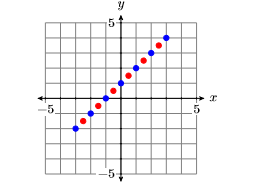
There are an infinite number of points that satisfy the equation \(y = x + 1\). In Figure \(\PageIndex{10}\), we’ve plotted only \(13\) points that satisfy the equation. However, the collection of points plotted in Figure \(\PageIndex{10}\) suggest that if we were to plot the remainder of the points that satisfy the equation \(y = x + 1\), we would get the graph of the line shown in Figure \(\PageIndex{11}\).

Sketch the graph of the equation \(y = −x + 2\).
- Answer
-
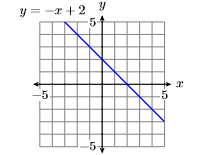
Interactive Exercise \(\PageIndex{3}\)
Guidelines and Requirements
Example \(\PageIndex{3}\) suggests that we should use the following guidelines when sketching the graph of an equation.
When asked to draw the graph of an equation, perform each of the following steps:
- Set up and calculate a table of points that satisfy the given equation.
- Set up a Cartesian Coordinate System on graph paper and plot the points in your table on the system. Label each axis (usually \(x\) and \(y\)) and indicate the scale on each axis.
- If the number of points plotted are enough to envision what the shape of the final curve will be, then draw the remaining points that satisfy the equation as imagined. Use a ruler if you believe the graph is a line. If the graph appears to be a curve, freehand the graph without the use of a ruler.
- If the number of plotted points do not provide enough evidence to envision the final shape of the graph, add more points to your table, plot them, and try again to envision the final shape of the graph. If you still cannot predict the eventual shape of the graph, keep adding points to your table and plotting them until you are convinced of the final shape of the graph.
Here are some additional recommendations for sketching the graph of an equation.
Graph paper, lines, curves, and rulers.
- All graphs are to be drawn on graph paper.
- All lines are to be drawn with a ruler. This includes the horizontal and vertical axes.
- If the graph of an equation is a curve instead of a line, then the graph should be drawn freehand, without the aid of a ruler.
Graphing with Technology
Luckily, when it comes to graphing, we can trust technology with performing this task. Instead of plugging in the values and plotting by points, let's discuss how technology can be used.
In Desmos Graphing Calculator, enter the equation then press Enter. For example, graphing \(y=x+1\) from Example \(\PageIndex{3}\) is shown below:
In WolframAlpha, enter the equation then press Enter. For example, graphing \(y=x+1\) from Example \(\PageIndex{3}\) is shown below:



